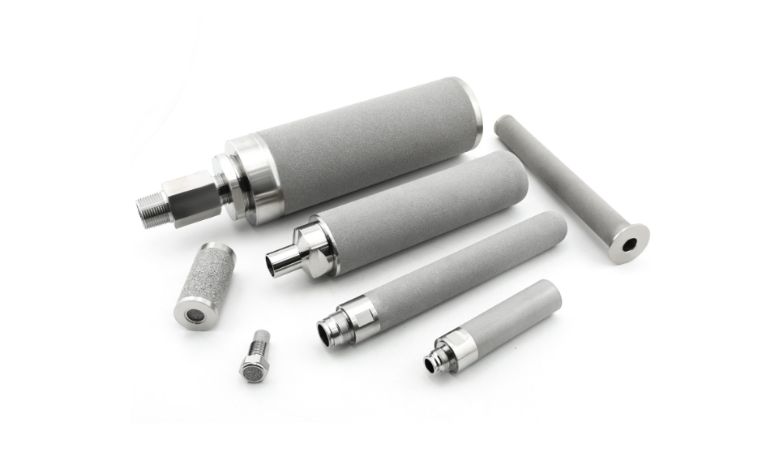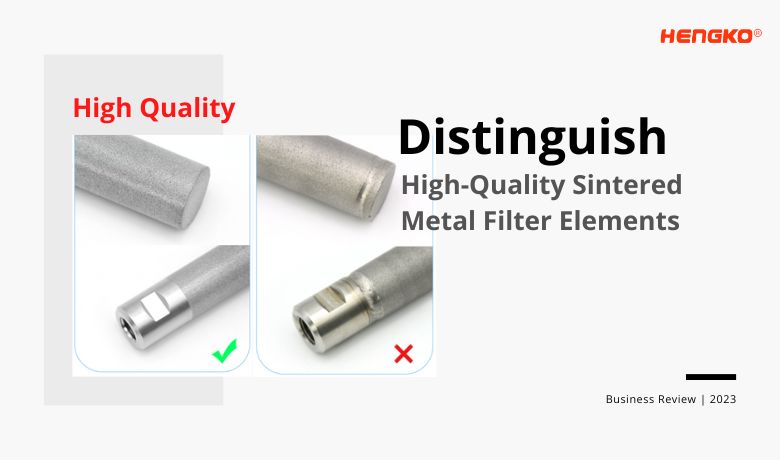How to Distinguish High-quality Sintered Metal Filter Elements ?
I.Introduction
A porous sintered filter is a type of filter made by sintering (heating and compressing) powders or particles together to form a solid material with a porous structure. These filters are used in a variety of applications, including filtration, separation, and purification. They are made of various materials such as stainless steel, aluminum and bronze. The porous structure allows fluids or gases to pass through while trapping and removing unwanted particles or impurities. The pore size and distribution, as well as the material properties, can be adjusted to suit the specific filtration application. These filters are known for their durability, high-temperature resistance, and chemical compatibility, and are often used in demanding industrial and scientific applications.
But there are various sintered filter elements on the market, how can we distinguish good quality sintered filter elements?
II. Explanation of sintered metal filters
Then What is the sintered metal filters ?
Sintered metal filters are important in many industrial and commercial applications, from fluid filtration to gas purification. However, not all sintered metal filters are created equal. It's important to distinguish high-quality sintered metal filters from those of lower quality to ensure that they will perform as expected and last for a long time. In this blog post, we will discuss the characteristics of high-quality sintered metal filters, methods for evaluating the quality of sintered metal filters, and the importance of selecting high-quality filters.
III.Importance of identifying high-quality filters
I. First, let's define what sintered metal filters are.
Sintered metal filters are made by compacting metal powder into a preformed shape and then heating it to a temperature just below the melting point. This process, called sintering, causes the metal particles to fuse, creating a solid piece with a porous structure. The pore size and porosity of the filter can be controlled by adjusting the size and shape of the metal particles and the sintering conditions. The porous structure of the filter allows fluid or gas to pass through while trapping unwanted particles.
II. Characteristics of High-Quality Sintered Metal Filters
Now, let's discuss the characteristics of high-quality sintered metal filters. A high-quality sintered metal filter should have a consistent and uniform pore size and high porosity. This ensures that the filter can trap the desired particles while allowing the fluid or gas to pass through with minimal restriction. High-quality sintered metal filters should also have high mechanical strength, withstand high pressures and resist deformation. Additionally, they should be chemically compatible, be resistant to corrosion and most chemicals, and be able to tolerate high temperatures without losing structural integrity.
A. Porous structure:
Consistent and uniform pore size: Porous sintered filters have a consistent and uniform pore size throughout the entire filter element. It allows for precise control over the filtration efficiency of the element.
High porosity: The porous structure of sintered filter elements allows for high flow rates and dirt-holding capacity.
B. Mechanical strength:
High resistance to pressure: Sintered filter elements have high resistance to pressure and can withstand high-pressure differential without deforming or becoming damaged.
Resistant to deformation: Sintered filter elements are known for their high mechanical strength and durability, making them suitable for use in harsh environments and able to withstand high pressure without deforming.
C. Chemical compatibility:
Resistant to corrosion: Sintered filter elements are typically made from materials resistant to corrosion, making them suitable for use in corrosive environments.
Resistant to most chemicals: Sintered filter elements are also typically made from materials resistant to a wide range of chemicals, making them suitable for chemical filtration applications.
D. Temperature tolerance:
Able to withstand high temperatures: Sintered filter elements can withstand high temperatures without losing their structural integrity or filtration efficiency.
Able to maintain structural integrity: Sintered filter elements can maintain their structural integrity even when exposed to high temperatures. It makes them suitable for use in high-temperature applications such as furnace filtration.
IV.Methods for Evaluating Quality of Sintered Metal Filters
Several methods can be used to evaluate the quality of sintered metal filters. One method is physical inspection, which includes visually examining the porous structure and measuring the pore size. Another method is mechanical testing, such as pressure drop and burst strength testing. Chemical compatibility testing, such as corrosion resistance and chemical resistance testing, can also be used to evaluate the quality of the filters. Finally, temperature testing, including high-temperature testing and thermal cycling testing, can be used to ensure that the filters will perform well in the intended application.
A. Physical Inspection:
Visual examination of porous structure: This type of testing involves looking at the filter material under a microscope or other magnification device to ensure that the porous structure is consistent and free of defects.
Measurement of pore size: This involves using specialized equipment to measure the size of the pores in the filter material. This information can be used to ensure that the filter is able to effectively remove the desired particles from a fluid.
B. Mechanical Testing:
Pressure drop testing: This type of testing measures the pressure drop across the filter material under different conditions, such as varying flow rates or different types of particles in the fluid. This information can be used to determine the filter's efficiency and to identify any potential issues with the filter's performance.
Burst strength testing: This test measure the maximum pressure a filter can withstand before failing.
C. Chemical compatibility testing:
Corrosion resistance testing: This type of testing is used to determine how well the filter material can resist corrosion when exposed to different types of chemicals. This information can be used to ensure that the filter is able to function effectively in the intended environment.
Chemical resistance testing: This test measure the filter material resistance against chemicals by exposing it to a specific chemical and measuring the changes in the filter material.
D. Temperature testing:
High temperature testing: This type of testing involves exposing the filter material to high temperatures to ensure that it can withstand the temperatures that it may be exposed to in its intended use.
Thermal cycling testing: This type of testing involves repeatedly exposing the filter material to both high and low temperatures to ensure that it can withstand repeated thermal stress without failing.
It's important to select high-quality sintered metal filters for several reasons. First, high-quality filters will perform better and last longer than lower-quality ones. This means that they will require less frequent replacement and maintenance, which can save time and money in the long run. High-quality filters will also be less likely to fail, preventing costly downtime and equipment damage. Additionally, high-quality filters will be better able to protect the equipment and process they are used in, which can improve the overall efficiency and effectiveness of the operation.

V.Conclusion
In conclusion, sintered metal filters are important in many industrial and commercial applications. It's important to distinguish high-quality sintered metal filters from those of lower quality to ensure that they will perform as expected and last for a long time. High-quality sintered metal filters should have a consistent and uniform pore size, high porosity, high mechanical strength, chemical compatibility, and temperature tolerance. Several methods can be used to evaluate the quality of sintered metal filters, including physical inspection, mechanical testing, chemical compatibility testing, and temperature testing. Selecting high-quality sintered metal filters can save time and money in the long run and improve the overall efficiency and effectiveness of the operation.
You can Check and Contact HENGKO filters for details, you are welcome to send email
by ka@hengko.com, we will send asap within 24-Hours with best introduce and best
fitration solution.
